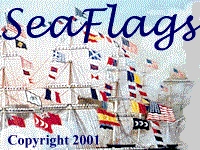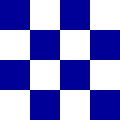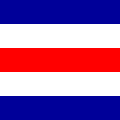Warning Signals (original) (raw)
 |
Maritime Warning Signals |
|---|
- Distress Signals
- Weather Signals
- Diving Signals Related material:
- Signal Flags Return to Sea Flags home page
Distress Signals
  |
 |
Rule 37 of the 1972 International Regulations for Preventing Collisions at Sea (enacted into U.S. Law as the International Navigation Act of 1977) and the United States Inland Navigation Rules provide for a number of signals to be used by a vessel in distress. Most of these use lights, sounds, flares, and similar means, but three of them rely on flags.The first is the International Code of Signals signal for "I am in distress and require immediate assistance," the ICS code flags N and C (known as NOVEMBER and CHARLIE.The second is an orange flag or other surface showing a black disk or ball next to or above a black square. The specific design of this flag is spelled out in 46 Code of Federal Regulations 160.072.The third (not shown) is a square flag of any color hoisted above any round shape. |
|---|---|---|
| November-Charlie | Orange Flag | |
 Inverted Ensign Inverted Ensign |
The use of an inverted ensign--the national flag flown upside down--as a distress signal dates back many years, apparently originating in British practice but carried over to the United States at an early date. The U.S. Flag Code says that the American flag should never be flown upside down except as a signal of dire distress, which would appear to give the practice official sanction.To be a useful distress signal, however, a flag must have an obvious right side up. Many national flags do not. As a result, neither the international nor U.S. inland rules of the road list the inverted ensign as a recognized sign of distress. Using it instead of one of the approved signals should therefore be avoided, as it may not be understood by other vessels, especially outside the United States. |
Weather Warning Signals
The United State Weather Bureau adopted a system of maritime weather warning flags in the early twentieth century. Originally, combinations of red pennants, white pennants, and red flags with black square centers were used to warn mariners that a storm was coming from a particular direction. In 1958, however, the present system of signals indicating the strength rather than the direction of the storm was introduced.
The National Weather Service discontinued posting these warnings at its own stations on February 15, 1989, on the grounds that they were less reliable than marine radio broadcasts and other modern methods of communication. However, the announcement also said that "U.S. Coast Guard and other stations may continue to display warning signals without the direct participation of the National Weather Service." A number of Coast Guard stations did indeed continue to post the warning flags, normally in response to local demand. However, the display was not predictable, giving rise to fears that mariners expecting but not seeing the flags hoisted would fail to keep up with weather conditions from the official Weather Service communications net. So on February 22, 2001, the Commandant of the Coast Guard issued a precise series of instructions on the hoisting of these flags at Coast Guard stations:
- The flags may be displayed only at locations determined by the commander of the appropriate Coast Guard district.
- If displayed at all, they must be displayed whenever a National Weather Service warning is in force for the area.
- The warnings must be displayed from one our before sunrise to one hour after sunset.
- They must be visible from a navigable waterway.
- The unit's entry in the National Oceanic and Atmospheric Administration's_U.S. Coast Pilot_ must indicate where the flags will be displayed, and the location must be marked on the navigation charts published by NOAA's National Ocean Survey. Return to top of page
Diving Signals
Two flags are mandated for display in most parts of the United States and Canada when a boat or ship has divers in the water. Considerable confusion exists as to the differences between these two flags, if any, and why a dive boat has to use two separate signals. In fact, the two flags serve quite different purposes.
The 1972 International Regulations for Preventing Collisions at Sea and the United States Inland Navigation Rules provide for an elaborate series of day-shapes and lights to be displayed by large vessels whose maneuverability is restricted by the conduct of underwater operations, such as cable-laying, dredging, or conducting diving operations. Smaller vessels that are not able to hoist the complex signals used by large ships are instead required to display a rigid version of the International Code of Signals flag for the letter "A," known as ALFA, at least one meter high if diving operations restrict their ability to maneuver. Not all boats from which divers are swimming are necessarily so restricted. Generally, only vessels to which the divers are physically connected by communication lines, air hoses, or the like are affected by this requirement. It does not apply to most instances of sport diving, where the divers are swimming free of the vessel. As recent Coast Guard Notices to Mariners emphasize: "The ALFA flag is a navigational signal intended to protect the vessel from collision."
By contrast, the red and white diver-down flag, originally devised in about 1957, is intended to protect divers themselves. This flag is often referred to as unofficial or voluntary because it is not mandated by the international or inland rules of the road. This assertion is erroneous. The use of the diver down flag is required by state law or regulation in virtually every state of the Union, as well as by various Federal agencies exercising jurisdiction over waters where diving takes place (such as the National Park Service) and by the Canadian Occupational Safety and Health Regulation. Typically, the laws or regulations on the use of this flag require divers to display the flag and to remain within a specified distance of it when they are near the surface. This often means the flag is best mounted on a float or buoy near the actual dive point rather than on the boat itself. Restrictions vary from state to state, but typically include a zone around the flag where no other boats are allowed and a second, larger zone in which their speed is limited. A number of states also prohibit the display of the diver-down flag when a diver is not actually in the water.
Sea Flags
Copyright 2000, 2001 by Joseph McMillan